Designing Training Programs to Introduce Emerging Technologies to Future Workers—A Pilot Study Based on the Example of Artificial Intelligence Enhanced Robotics
Abstract
:1. Introduction
2. Materials
2.1. AI-Enhanced Robotics
2.2. ClearBot and Poppy Ergo Jr
2.3. UR3e Collaborative Robot
3. Phase 1: Workshop “My Future Colleague Robot”
3.1. Method
3.1.1. Description and Implementation
3.1.2. Data Collection and Analysis
- Please describe what role, in your opinion, the intelligent robots will play at your workplace after 10 years. Do you see them as friends, colleagues or tools?
- Please describe what role, in your opinion, the intelligent robots will play in your personal life after 10 years. Do you see them as family members, friends, slaves or tools?
3.1.3. Sample
3.2. Results
3.3. Discussion
4. Phase 2: Training Course “My Future Colleague Robot”
4.1. Method
4.1.1. Training Course Description and Implementation
4.1.2. Data Collection and Analysis
- Items about the participant’s feedback on the training course performance, with Likert rating scale from 1 (strongly disagree) to 6 (strongly agree):
- Did the training content match your expectations?
- Please rate how much do you know about using the UR3e robotic arm?
- Please rate how much are you able to offer suggestions for using the UR3e robotic arm in your work?
- How much can you use learned skills in your daily work/activities?
- Multiple-choice item about the participant’s feedback on the training course topics:
- Please evaluate, which training course topics were the most needed and interesting for you?
- ○
- Introduction of the world of robotics
- ○
- The role of robots in shaping a sustainable world
- ○
- Ethics aspects of using robots
- ○
- Demonstrations of the UR3e collaborative robotic arm
- ○
- Work safety with collaborative robots
4.1.3. Sample
4.2. Results
4.3. Discussion
5. Conclusions
Limitations and Future Work
Author Contributions
Funding
Institutional Review Board Statement
Informed Consent Statement
Data Availability Statement
Conflicts of Interest
References
- Rahman, A.A.; Hamid, U.Z.; Thoo, A. Emerging technologies with disruptive effects: A review. PERINTIS Ejournal 2017, 7, 111–128. [Google Scholar]
- OECD. Getting Skills Right: Future-Ready Adult Learning Systems; OECD Publishing: Paris, France, 2019. [Google Scholar] [CrossRef]
- OECD. Future of Education and Skills 2030. Concept Note; OECD Publishing: Paris, France, 2018. [Google Scholar]
- Rotolo, D.; Hicks, D.; Martin, B. What is an emerging technology? Res. Policy 2015, 44, 1827–1843. [Google Scholar] [CrossRef] [Green Version]
- Maddox, T. Top 10 Emerging Technologies of 2020: Winners and Losers. Technology Advice. Available online: https://www.techrepublic.com/article/top-10-emerging-technologies-of-2020-winners-and-losers/ (accessed on 5 October 2021).
- Kurzweil, R. The Singularity Is Near: When Humans Transcend Biology; Viking Adult: New York, NY, USA, 2005. [Google Scholar]
- Bugmann, G.; Siegel, M.; Burcin, R. A Role for Robotics in Sustainable Development? In Proceedings of the IEEE Africon 11, Victoria Falls, Zambia, 13–15 September 2011. [Google Scholar] [CrossRef]
- Manyika, J.; Chui, M.; Miremadi, M.; Bughin, J.; George, K.; Willmott, P.; Dewhurst, M. Harnessing Automation for a Future That Works; McKinsey Global Institute: San Fransisco, CA, USA, 2017. [Google Scholar]
- McKibben, B. Enough: Staying Human in an Engineered Age; Times Books: New York, NY, USA, 2003. [Google Scholar]
- Ford, M.R. The Lights in the Tunnel: Automation, Accelerating Technology and the Economy of the Future; Acculant Publishing: Scotts Valley, CA, USA, 2009. [Google Scholar]
- Schwartz, J.; Collins, L.; Stocton, H.; Wagner, D.; Walsh, B. The Future of Work. In Rewriting the rules for the Digital Age; Deloitte University Press: New York, NY, USA, 2017. [Google Scholar]
- Manyika, J.; Lund, S.; Chui, M.; Bughin, J.; Woetzel, J.; Batra, P.; Ko, R.; Sanghvi, S. Jobs Lost, Jobs Gained: Workforce Transitions in a Time of Automation; McKinsey Global Institute: San Francisco, CA, USA, 2017. [Google Scholar]
- Rios, J.A.; Ling, G.; Pugh, R.; Becker, D.M.; Bacall, A.N. Identifying critical 21st Century for workplace success: A content analysis of job advertisements. Educ. Res. 2020, 49, 80–89. [Google Scholar] [CrossRef] [Green Version]
- Voogt, J.; Roblin, N.P. 21st Century Skills. Discussion Paper; University of Twente: Enschede, The Netherlands, 2010. [Google Scholar]
- Eagly, A.H.; Chaiken, S.C. Attitude structure and function. In The Handbook of Social Psychology; Gilbert, D.T., Fiske, S.T., Lindzey, G., Eds.; McGraw-Hill: New York, NY, USA, 1998; pp. 269–322. [Google Scholar]
- Fazio, R.H.; Roskos-Ewoldsen, D.R. Acting as we feel: When and how attitudes guide behavior. In Persuasion: Psychological Insights and Perspectives; Brock, T.C., Green, M.C., Eds.; Sage Publications: Thousand Oaks, CA, USA, 2005; pp. 41–62. [Google Scholar]
- Gnambs, T.; Appel, M. Are robots becoming unpopular? Changes in attitudes towards autonomous robotic systems in Europe. Comput. Hum. Behav. 2019, 93, 53–61. [Google Scholar] [CrossRef] [Green Version]
- Dang, J.; Liu, L. Robots are friends as well as foes: Ambivalent attitudes toward mindful and mindless AI robots in the United States and China. Comput. Hum. Behav. 2021, 115, 106612. [Google Scholar] [CrossRef]
- Sinclair, J.; Aho, A.-M. Experts on super innovators: Understanding staff adoption of learning management systems. High. Educ. Res. Dev. 2017, 1, 158–172. [Google Scholar] [CrossRef]
- Reich-Stiebert, N.; Eyssel, F.; Hohnemann, C. Involve the user! Changing attitudes toward robots by user participation in a robot prototyping process. Comput. Hum. Behav. 2019, 91, 290–296. [Google Scholar] [CrossRef]
- Li, D.; Kulasegaram, K.; Hodges, B. Why We Needn’t Fear the Machines: Opportunities for Medicine in a Machine Learning World. Acad. Med. 2019, 94, 623–625. [Google Scholar] [CrossRef]
- Adner, R.; Levinthal, D.A. The Emergence of Emerging Technologies. Calif. Manag. Rev. 2002, 45, 50–66. [Google Scholar] [CrossRef] [Green Version]
- Ziemnowicz, C.; Joseph, A. Schumpeter and Innovation. In Encyclopedia of Creativity, Invention, Innovation and Entrepreneurship, 2nd ed.; Carayannis, E.G., Ed.; Springer: Cham, Switzerland, 2020. [Google Scholar]
- Rogers, E.M. Diffusion of Innovations, 5th ed.; Free Press: New York, NY, USA, 2003. [Google Scholar]
- Davis, F.D. Technology Acceptance Model for Empirically Testing New End-User Information Systems: Theory and Results. Ph.D. Thesis, Massachusetts Institute of Technology, Massachusetts, CA, USA, 1985. [Google Scholar]
- Leoste, J. Adopting and Sustaining Technological Innovations in Teachers’ Classroom Practices—The Case of Integrating Educational Robots into Math Classes. Ph.D. Thesis, Tallinn University, Tallinn, Estonia, 2021. [Google Scholar]
- Niederhauser, D.S.; Howard, S.K.; Voogt, J.; Agyei, D.D.; Laferriere, T.; Tondeur, J.; Cox, M.J. Sustainability and Scalability in Educational Technology. Technol. Knowl. Learn 2018, 23, 507–523. [Google Scholar] [CrossRef] [Green Version]
- Trentin, G.; Alvino, S. Faculty training as a key factor for Web Enhanced Learning sustainability. In Faculty Training for Web-Enhanced Learning; Repetto, M., Trentin, G., Eds.; Nova Science Publishers Inc.: Hauppauge, NY, USA, 2011. [Google Scholar]
- Davis, F.D.; Bagozzi, R.P.; Warshaw, P.R. User acceptance of computer technology: A comparison of two theoretical models. Manag. Sci. 1989, 35, 982–1003. [Google Scholar] [CrossRef] [Green Version]
- DePietro, R.; Wiarda, E.; Fleischer, M. The context for change: Organization, technology and environment. In The Process of Technological Innovation; Tornatzky, L.G., Fleischer, M., Eds.; Lexington Books: Lexington, KY, USA, 1990; pp. 151–175. [Google Scholar]
- Venkatesh, V.; Morris, M.G.; Davis, G.B.; Davis, F.D. User acceptance of information technology: Toward a unified view. MIS Q. 2003, 27, 425–478. [Google Scholar] [CrossRef] [Green Version]
- Cruz-Jesus, F.; Pinheiro, A.; Oliveira, T. Understanding CRM adoption stages: Empirical analysis building on the TOE framework. Comput. Ind. 2019, 109, 1–13. [Google Scholar] [CrossRef]
- Ko, E.; Kim, S.; Kim, M.; Woo, J. Organizational characteristics and the CRM adoption process. J. Bus. Res. 2008, 61, 65–74. [Google Scholar] [CrossRef]
- Haberli, C.; Oliveira, T.; Yanaze, M. The adoption stages (Evaluation, Adoption, and Routinisation) of ERP systems with business analytics functionality in the context of farms. Comput. Electron. Agric. 2019, 156, 334–338. [Google Scholar]
- Goodarzi, S.H.; Masini, A.; Aflaki, S.; Fahimnia, B. Right Information at the Right Time: Reevaluating the Attitude–Behavior Gap in Environmental Technology Adoption. Int. J. Prod. Econ. 2021, 242, 108278. [Google Scholar] [CrossRef]
- Puklavec, B.; Oliveira, T.; Popovic, A. Understanding the determinants of business intelligence system adoption stages: An empirical study of SMEs. Ind. Manag. Data Syst. 2018, 118, 236–261. [Google Scholar] [CrossRef]
- Zhu, K.; Kraemer, K.; Xu, S. The process of innovation assimilation by firms in different countries: A technology diffusion perspective on e-business. Manag. Sci. 2006, 52, 1557–1576. [Google Scholar] [CrossRef] [Green Version]
- Nguyen, T.; Petersen, T.E. Technology Adoption in Norway: Organizational Assimilation of Big Data. Master′s Thesis, Norwegian School of Economics, Bergen, Norway, 2017. [Google Scholar]
- Sepasgozar, S.M.; Davis, S.; Loosemore, M.; Bernold, L.E. An investigation of modern building equipment technology adoption in the Australian construction industry. Eng. Constr. Archit. Manag. 2018, 25, 1075–1091. [Google Scholar] [CrossRef]
- Brooks-Harris, J.E.; Stock-Ward, S.R. Workshops: Designing and Facilitating Experiential Learning; SAGE Publications: Thousand Oaks, CA, USA, 1999. [Google Scholar]
- Belay, H.; Ruairc, B.Ó.; Guérandel, A. Workshops: An important element in medical education. BJPsych Adv. 2019, 25, 7–13. [Google Scholar] [CrossRef]
- Tessema, B.S.; Abejehu, S.B. University-Industry Collaboration in Curriculum Development: Analysis of Banking and Finance Graduates’ Attributes from Educators and Industries Perspective. Educ. J. 2017, 6, 87–93. [Google Scholar] [CrossRef] [Green Version]
- Matkovic, P.; Tumbas, P.; Sakal, M.; Pavlicevic, V. Curriculum Development Process. Redesign based on University-Industry Cooperation. In Proceedings of the 6th International Conference on Education and New Learning Technologies, Barcelona, Spain, 7–9 July 2014. [Google Scholar]
- Khare, M. Employability and higher education in India: The missing links. High. Educ. Future 2014, 1, 39–62. [Google Scholar] [CrossRef]
- Sarker, F.; Davis, H.; Tiropanis, T. A review of higher education challenges and data infrastructure responses. In Proceedings of the International Conference for Education Research and Innovation (ICERI2010), Madrid, Spain, 15–17 November 2010. [Google Scholar]
- Howard, D.; Eiben, A.E.; Kennedy, D.F.; Mouret, J.-B.; Valencia, P.; Winkler, D. Evolving embodied intelligence from materials to machines. Nat. Mach. Intell. 2019, 1, 12–19. [Google Scholar] [CrossRef]
- Hennick, C. Leaps, Bounds, and Backflips. Boston Dynamics. Available online: http://blog.bostondynamics.com/atlas-leaps-bounds-and-backflips (accessed on 5 October 2021).
- Stein, J.P.; Liebold, B.; Ohler, P. Stay back, clever thing! Linking situational control and human uniqueness concerns to the aversion against autonomous technology. Comput. Hum. Behav. 2019, 95, 73–82. [Google Scholar] [CrossRef]
- Zhou, S.; Tian, L. Would You Help a Sad Robot? Influence of Robots’ Emotional Expressions on Human-Multi-Robot Collaboration. In Proceedings of the 29th IEEE International Conference on Robot and Human Interactive Communication (RO-MAN), Naples, Italy, 31 August–4 September 2020. [Google Scholar] [CrossRef]
- Müller-Abdelrazeq, S.L.; Schönefeld, K.; Haberstroh, M.; Hees, F. Interacting with Collaborative Robots—A Study on Attitudes and Acceptance in Industrial Contexts. In Social Robots: Technological, Societal and Ethical Aspects of Human-Robot Interaction; Human–Computer Interaction Series; Korn, O., Ed.; Springer: Cham, Switzerland, 2019. [Google Scholar] [CrossRef]
- Oracle, S. Money and Machines: 2021 Global Study; Oracle Corporation: Austin, TX, USA, 2021. [Google Scholar]
- Universal Robots. Universal Robot Ur3e. 2021. Available online: https://www.universal-robots.com/products/ur3-robot/ (accessed on 5 October 2021).
- Leoste, J.; Viik, T.; San Martín López, J.; Kangur, M.; Vunder, V.; Mollard, Y.; Õun, T.; Tammo, H.; Paekivi, K. Robots as my future colleagues: Changing attitudes towards collaborative robots by means of experience-based workshops. In Ludic, Co-design and Tools Supporting Smart Learning Ecosystems and Smart Education. Smart Innovation, Systems and Technologies; Mealha, Ó., Dascalu, M., Di Mascio, T., Eds.; Springer: Singapore, 2021; Volume 249. [Google Scholar]
- Huxley, K. Content Analysis, Quantitative. In SAGE Research Methods, Content Analysis, Coding; Atkinson, P., Delamont, S., Cernat, A., Sakshaug, J.W., Williams, R.A., Eds.; SAGE Publications: Thousand Oaks, CA, USA, 2020. [Google Scholar]
- Smith, J.A.; Flowers, P.; Larkin, M. Interpretative Phenomenological Analysis: Theory, Method and Research; SAGE Publications: Thousand Oaks, CA, USA, 2009. [Google Scholar]
- Noble, H.; Smith, J. Issues of validity and reliability in qualitative research. Evid.-Based Nurs. 2015, 18, 34–35. [Google Scholar] [CrossRef] [Green Version]
- McDonald, N.; Schoenebeck, S.; Forte, A. Reliability and Inter-rater Reliability in Qualitative Research: Norms and Guidelines for CSCW and HCI Practice. Proc. ACM Hum.-Comput. Interact. 2019, 3, 1–23. [Google Scholar] [CrossRef] [Green Version]
- Inglis, D. Combating skill fade: Basic life support refresher training in the remote military environment. Resuscitation 2019, 142, E53–E54. [Google Scholar] [CrossRef]
- Leoste, J.; Ley, T.T.; Heidmets, M.; Stepanova, J. The Role of Social Practices of Knowledge Appropriation for Sustaining TEL Innovations in the Classroom. In Technology-Enhanced Learning for a Free, Safe, and Sustainable World. EC-TEL 2021; Lecture Notes in Computer Science; De Laet, T., Klemke, R., Alario-Hoyos, C., Hilliger, I., Ortega-Arranz, A., Eds.; Springer: Cham, Switzerland, 2021; Volume 12884. [Google Scholar]
- Leoste, J.; Heidmets, M.; Ley, T.T.; Stepanova, J. Classroom Innovation Becoming Sustainable: A Study of Technological Innovation Adoption by Estonian Primary School Teachers. IxDA Interact. Des. Archit. 2020, 47, 144–166. [Google Scholar]
- Stephan, M.; Brown, D.; Erickson, R. Talent Acquisition. In Rewriting the Rules for the Digital Age; Deloitte University Press: New York, NY, USA, 2017. [Google Scholar]
- Pelster, B.; Johnson, D.; Stempel, J.; van der Vyver, B. Careers and Learning. In Rewriting the Rules for the Digital Age; Deloitte University Press: New York, NY, USA, 2017. [Google Scholar]
- OECD. The Human Side of Productivity Uncovering the Role of Skills and Diversity for the Productivity of Firms. Key Highlights; OECD Publishing: Paris, France, 2021. [Google Scholar]
- Volini, E.; Schwartz, J.; Eaton, K.; Mallon, D.; Van Durme, Y.; Hauptmann, M.; Poynton, S.; Schoble-Williams, N. The Worker-Employer Relationship Disrupted; Deloitte Insight: New York, NY, USA, 2021. [Google Scholar]
- Irwin, N. Workers are gaining leverage over employers right before our eyes. New York Times, 5 June 2021. [Google Scholar]
- Eze, S.C.; Chinedu-Eze, V.C. Examining information and communication technology (ICT) adoption in SMEs: A dynamic capabilities approach. J. Enterp. Inf. Manag. 2018, 31, 338–356. [Google Scholar]
- Febrianda, R. Mobile App Technology Adoption in Indonesia’s Agricultural Sector. An Analysis of Empirical View from Public R&D Agency. STI Policy Manag. 2021, 6, 31–40. [Google Scholar]
- Clayton, J.; Elliott, R.; Iwata, J. Exploring the use of micro-credentialing and digital badges in learning environments to encourage motivation to learn and achieve. In Rhetoric and Reality: Critical Perspectives on Educational Technology; Hegarty, B., McDonald, J., Loke, S.-K., Eds.; Ascilite: Dunedin, New Zealand, 2014. [Google Scholar]
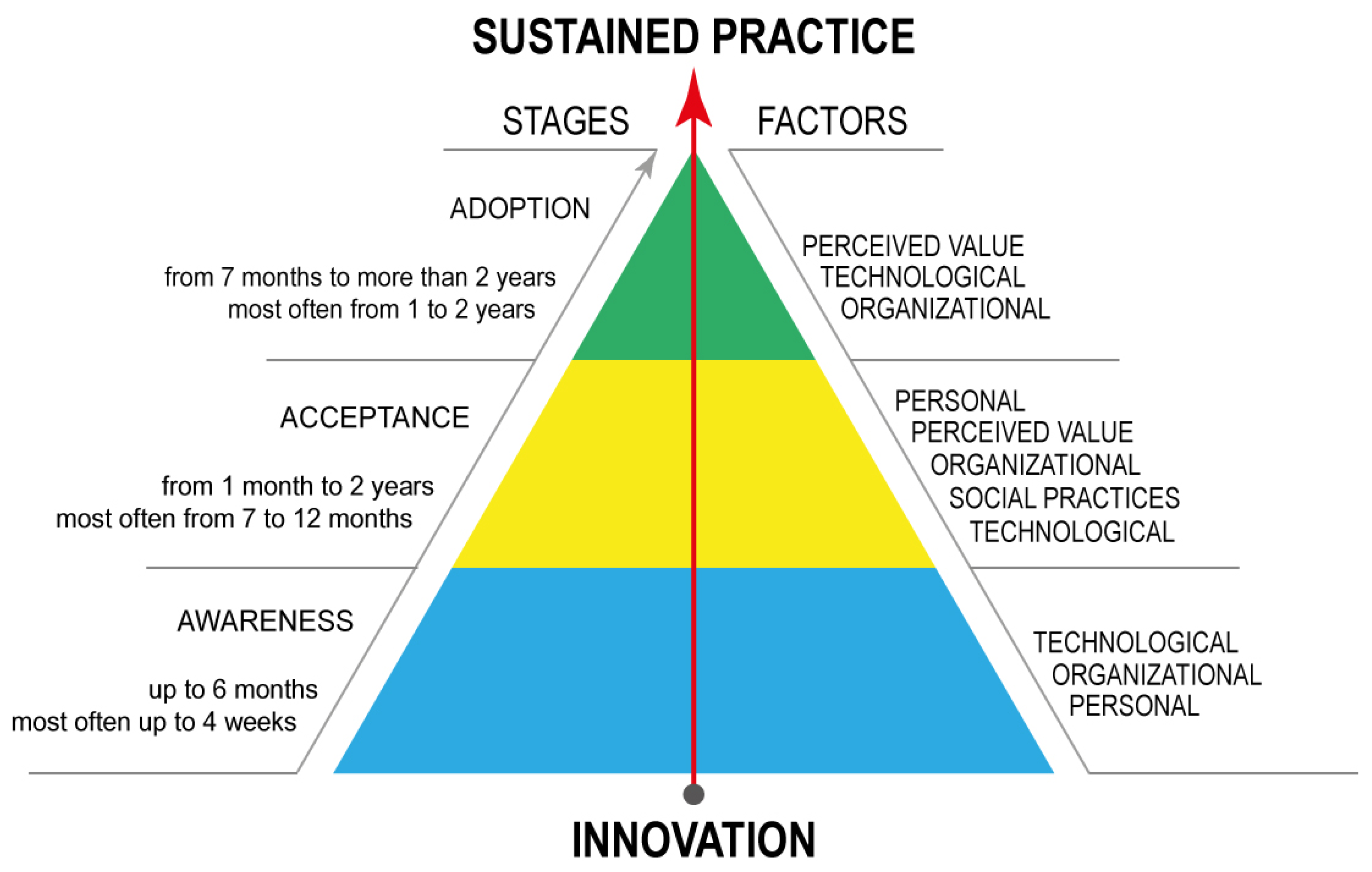
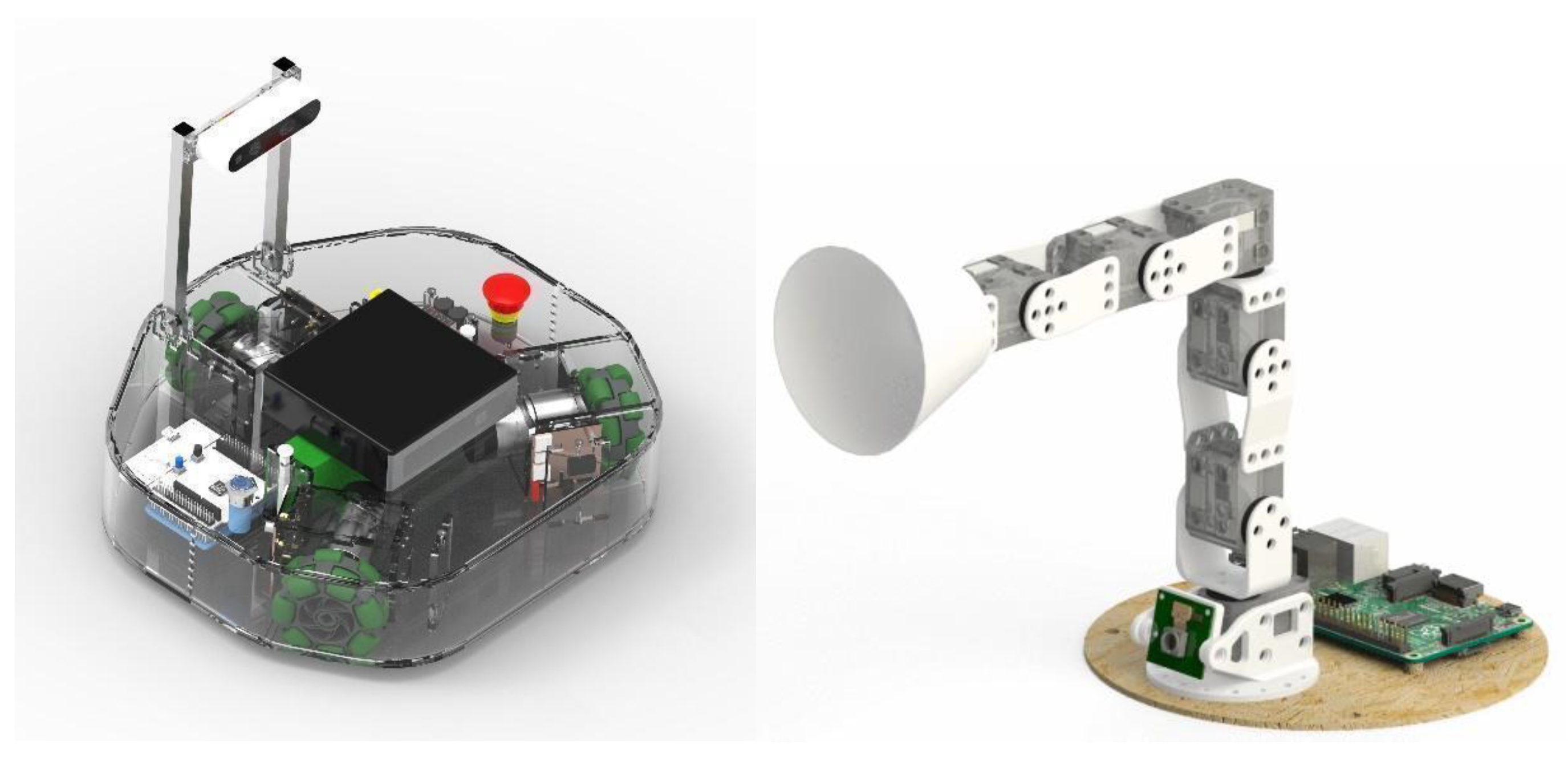
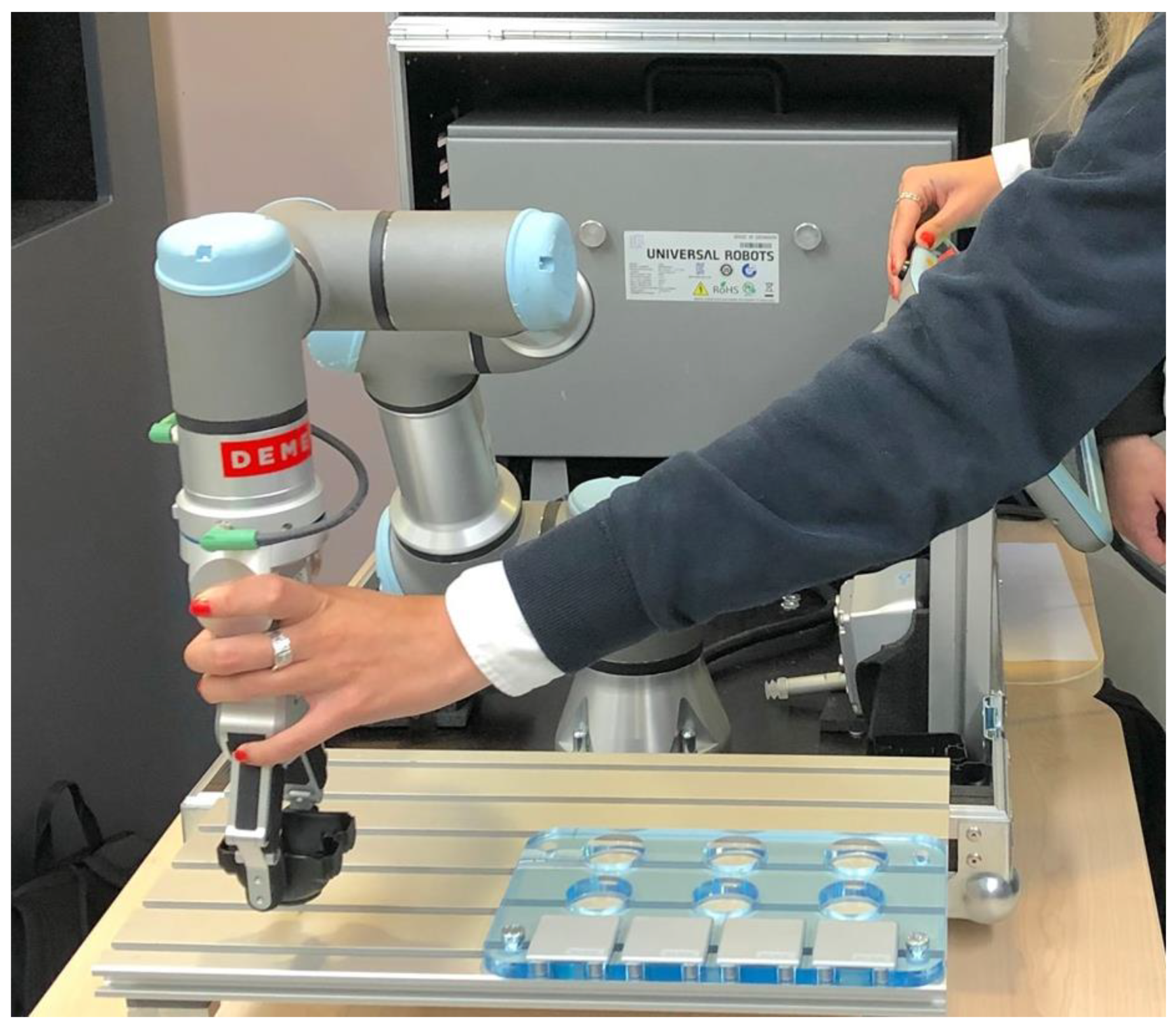

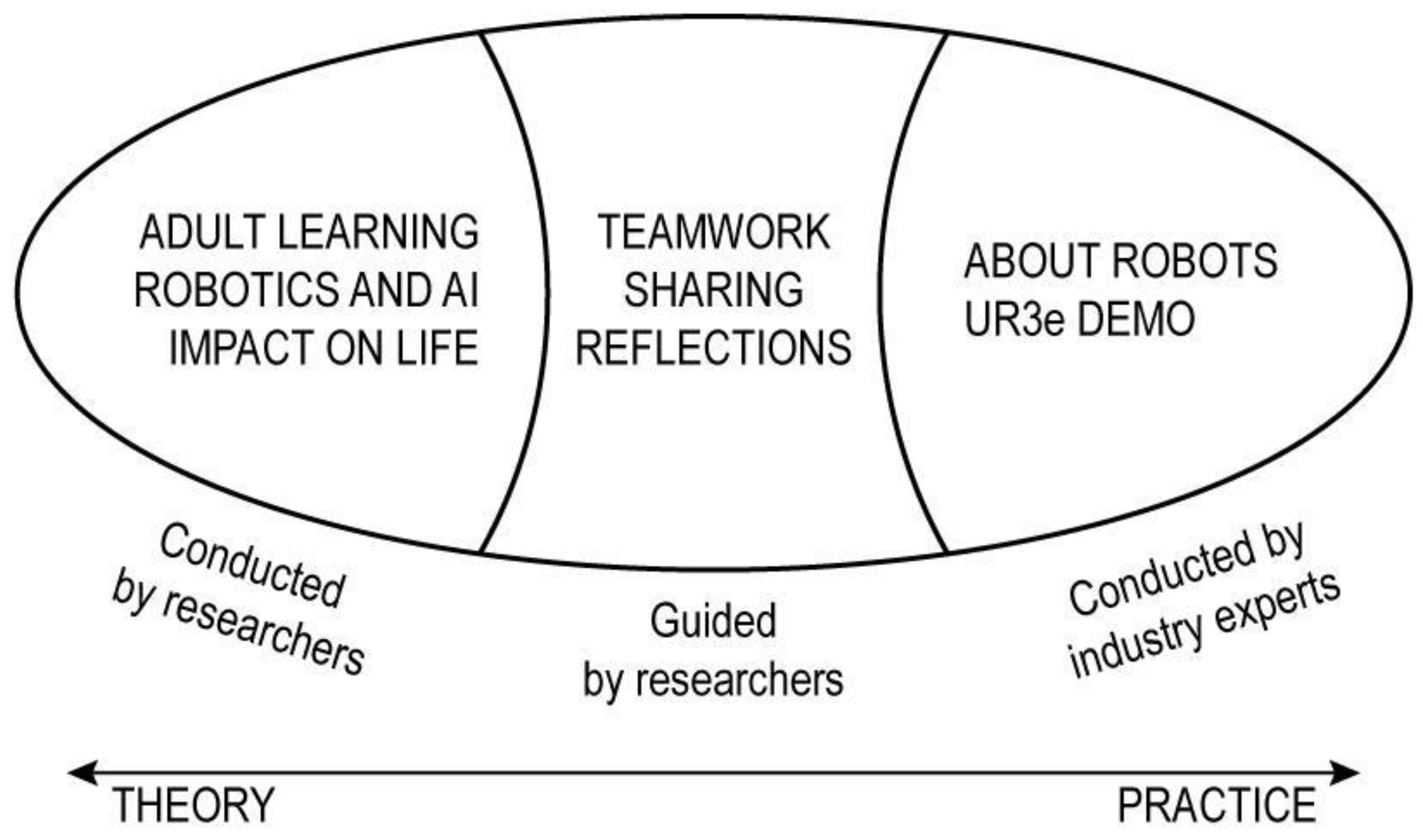
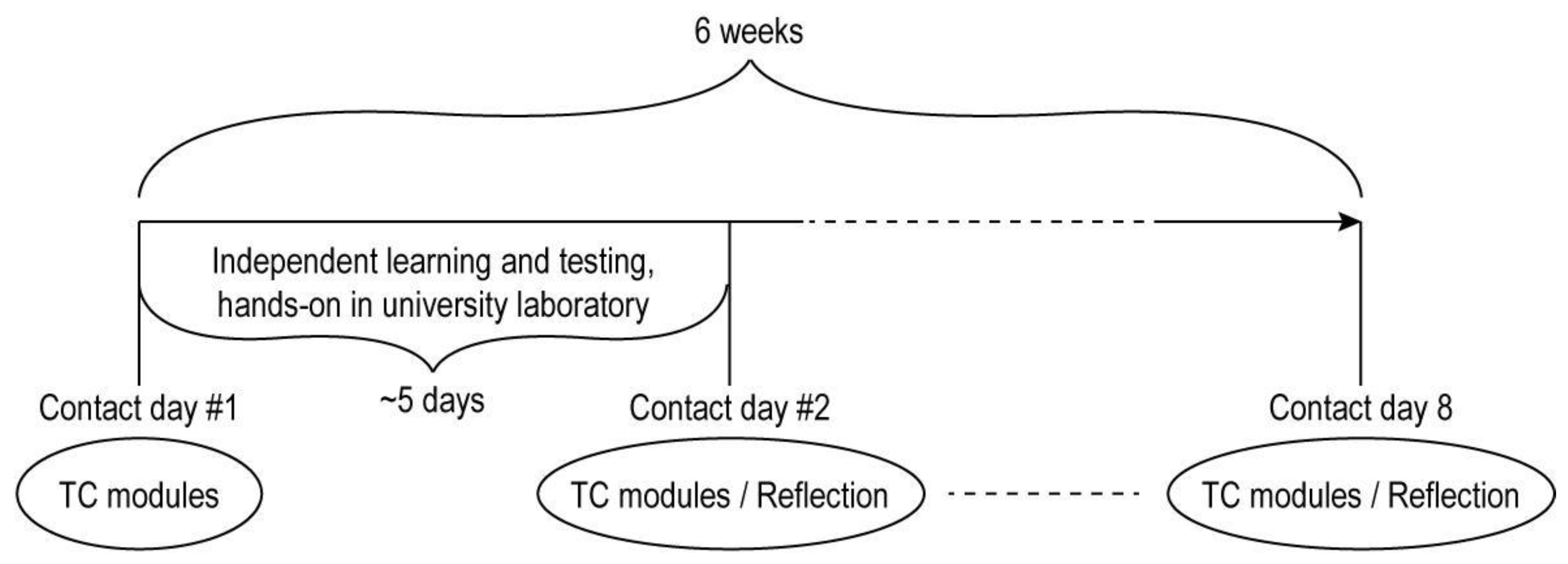
| Code | Expressed by Percentage of Learners | Delta |
|---|---|---|
| At workplace | ||
| Tools | 62% | 18% |
| Colleagues | 54% | −9% |
| Friends | 38% | 7% |
| At home | ||
| Tools | 92% | 4% |
| Servants | 38% | 13% |
| Friends | 23% | 2% |
| Code | Presence in the Participants’ Essays |
|---|---|
| Had previous experience with AIER | 11% |
| This was the first contact with AIER | 56% |
| Self-observed growth self-confidence related to AIER | 78% |
| Self-observed growth of knowledge about AIER | 78% |
| Got new ideas on how to use AIER | 33% |
| Became interested in learning more about AIER | 33% |
| Rating Scale Item | Average Rating | Percentage of Learners Per Rating Point | |||||
|---|---|---|---|---|---|---|---|
| 1 | 2 | 3 | 4 | 5 | 6 | ||
| Did the training content match your expectations? | 4.2 | - | - | 30% | 30% | 30% | 10% |
| Please rate how much do you know about using the UR3e robotic arm? | 3.4 | 10% | - | 40% | 40% | 10% | - |
| Please rate how much are you able to offer suggestions for using the UR3e robotic arm in your work? | 3.8 | 10% | - | 30% | 30% | 20% | 10% |
| How much can you use what you learned in your daily work and activities? | 3.3 | - | 10% | 60% | 20% | 10% | - |
| Item | Percentage of Learners |
|---|---|
| Please evaluate, which training course topics were the most needed and interesting for you? | |
| Introduction of the world of robotics | 50% |
| The role of robots in shaping a sustainable world | 80% |
| Ethics aspects of using robots | 40% |
| Demonstrations of the UR3e collaborative robotic arm | 70% |
| Work safety with collaborative robots | 30% |
Publisher’s Note: MDPI stays neutral with regard to jurisdictional claims in published maps and institutional affiliations. |
© 2021 by the authors. Licensee MDPI, Basel, Switzerland. This article is an open access article distributed under the terms and conditions of the Creative Commons Attribution (CC BY) license (https://creativecommons.org/licenses/by/4.0/).
Share and Cite
Leoste, J.; Õun, T.; Loogma, K.; San Martín López, J. Designing Training Programs to Introduce Emerging Technologies to Future Workers—A Pilot Study Based on the Example of Artificial Intelligence Enhanced Robotics. Mathematics 2021, 9, 2876. https://doi.org/10.3390/math9222876
Leoste J, Õun T, Loogma K, San Martín López J. Designing Training Programs to Introduce Emerging Technologies to Future Workers—A Pilot Study Based on the Example of Artificial Intelligence Enhanced Robotics. Mathematics. 2021; 9(22):2876. https://doi.org/10.3390/math9222876
Chicago/Turabian StyleLeoste, Janika, Tiia Õun, Krista Loogma, and José San Martín López. 2021. "Designing Training Programs to Introduce Emerging Technologies to Future Workers—A Pilot Study Based on the Example of Artificial Intelligence Enhanced Robotics" Mathematics 9, no. 22: 2876. https://doi.org/10.3390/math9222876
APA StyleLeoste, J., Õun, T., Loogma, K., & San Martín López, J. (2021). Designing Training Programs to Introduce Emerging Technologies to Future Workers—A Pilot Study Based on the Example of Artificial Intelligence Enhanced Robotics. Mathematics, 9(22), 2876. https://doi.org/10.3390/math9222876







